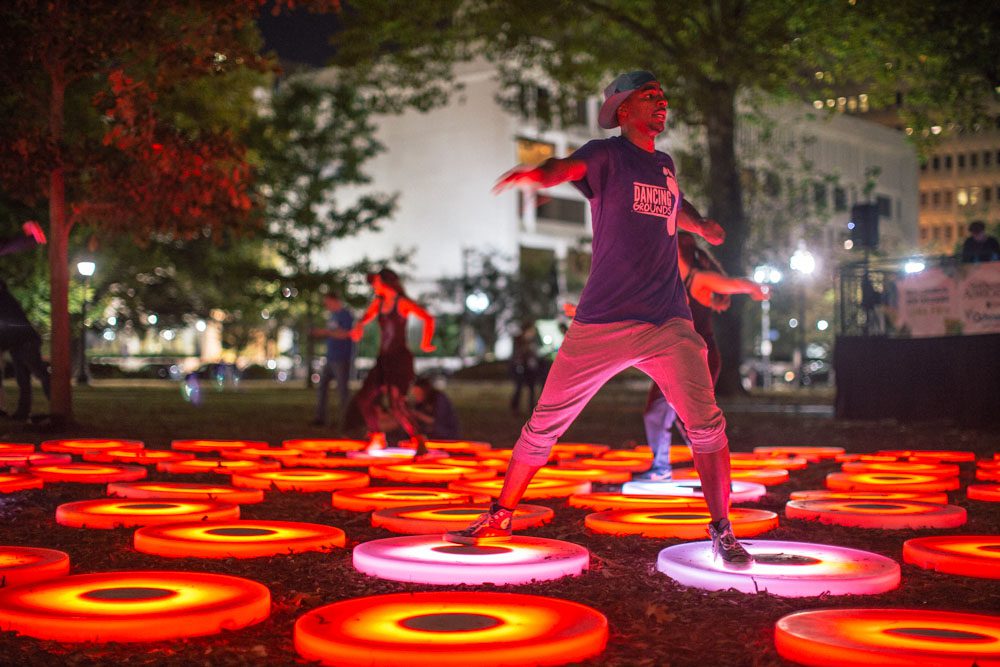Lux Aeterna: LUNA Fête returns to New Orleans
Benjamin Morris visits the Arts Council New Orleans’ second annual LUNA Fête and contemplates the power of light in public spaces.

Installation view of Jen Lewin Studio’s The Pool at Lafayette Square, New Orleans. Photo by Marcus Alfred.
Particle, wave, metaphor, symbol, idea, material: few substances in our universe are as enigmatic or hard-working as light. Yet it is only within the past century and a half that we have learned to tame it, to manufacture it, and to harness it for our purposes. As the writer Roberto Casati details in The Shadow Club, until the invention of incandescence, light (or the absence thereof) has for the vast majority of human existence regulated our activities.
Recognizing the power of light to transform public spaces, the Arts Council New Orleans hosted its second LUNA Fête in New Orleans earlier this month. Intended both to showcase new installations exploring light as a material and to bring works to areas not widely served by the arts, the festival offered visitors a variety of light-based pieces. Spread across three campuses (Julia Street, Oretha Castle Haley Boulevard, and Lafayette Square), these included projections, interactive music and game displays, and video pieces in both abstract and narrative formats.
Among the most innovative was Boulder-based Jen Lewin’s The Pool, a piece appearing for the first time in New Orleans at Lafayette Square. If darkness is often associated with the unknown, the uncertain, and the dangerous, Lewin reclaimed a space—usually darkened after business hours—by filling it with light, in this instance using touch-sensitive pads laid on the ground. Stepping on one of the pads yielded a bright explosion of color, swirling and blending before fading, inviting participants to either step on it again or move to the next.
With dozens of pads arranged in large concentric circles, the piece offered a playground of light and color in the midst of an otherwise shadowed space, beckoning adults and children alike to walk, leap, or dance as much as possible to keep the effect going. (The music, uptempo nightclub rave tunes during my visit, helped.) Understandably, little persuasion was required: indeed, there was something genuinely magical and transportive about seeing light explode underneath one’s feet, almost as if one were walking on the Bifrost rainbow bridge of Norse mythology. To stand in the middle of the installation, immersed in a bath of light, hearing the sounds of joy and delight from every angle, was a rare experience—one for which it was difficult not to feel grateful.
Interestingly, throughout the week, the spontaneous interactions that The Pool invited spawned more organized performances such as mass yoga or flash mobs dancing on the lights. These extended beyond those directly sponsored by the Arts Council to include groups that organized themselves to engage with the piece, suggesting that, properly arranged, light exhibits a magnetism all its own, one that must be shared to be appreciated.
An intriguing parallel comes in the example of the Condé Nast building during the New York blackout of 2003; amid a suddenly darkened city, a tower of light drew crowds from miles around, creating a collective experience of refuge, of solidarity, of safe haven. While New Orleans still labors painfully towards repairing its infrastructure—blighted lots, ravaged streets, and broken streetlights—installations like The Pool offer powerful reminders that light alone can serve as a tool to draw communities in to reclaim public space. One wonders: concerns of light pollution aside, were all the city’s squares and streets so lit, what would be the impact on our neighborhoods? On crime?
That a substance so ineffable could also be so useful remains a source of perpetual fascination. Indeed, elusive yet controllable, mysterious yet approachable, light remains, as it always has, a source of wonder. At one point during my visit, a two-year-old stood transfixed atop one of the glowing pads, utterly stunned at what her tiny footsteps had produced. As we return to the prosaic, darkened earth, her reaction remains a lesson. We should all ever be so amazed.
Editor's Note
Arts Council New Orleans’ LUNA Fête ran from November 29 - December 5, 2015 at various locations in New Orleans.



